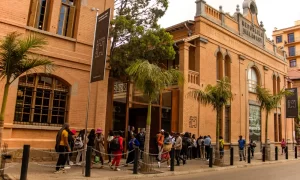
In a country ravaged by food and health emergencies, art is vital, says Hobisoa Raininoro. “It is important to bring a note of hope, to show beauty, creativity, and provide nourishment for the mind and imagination,” says the co-curator of the inaugural exhibition at Madagascar’s first major contemporary art venue, Fondation H.
Until last year, Madagascar had a vibrant art scene but no public museum of modern art or art school. Then, in April – after two years of restoration – a former post office in the capital, Antananarivo, opened its doors as Fondation H’s new gallery.
Its first exhibition, Bientôt je vous tisse tous – “soon I will weave you all” – runs until the end of February, and has been dedicated to Zoarinivo Razakaratrimo, a doyenne of Malagasy art. Known as Madame Zo, her work has been exhibited across the world and acquired by the Smithsonian’s National Museum of African Art in Washington.
The Fondation H exhibition is the first time the textile artist, who died in 2020, has been showcased at such scale in her homeland.
Madame Zo was famous for her use of weaving, an ancestral tradition that continues to flourish. Her work drew inspiration from lamba, a wrap made of silk or cotton worn by both sexes in Madagascar and used by mothers to tie newborns to their back and as a burial shroud.
Visitors to Fondation H are greeted by vast woven works hanging from tall ceilings, filling all five rooms over two floors of the large exhibition space.
“Madame Zo developed an extremely complex technique, freeing herself from the limitations of material or format,” says Raininoro.
“She had her own artistic language – her weavings have unusual shapes and sizes thanks to looms that she made herself.
“They integrate several hundred materials such as newsprint, magnetic tapes, electronic components, copper, bones, medicinal plants, industrial foam, rubber, wood chips or perishable foods.”
